Literacy Development through Critical Literacies in Early Childhood Education
VerifiedAdded on 2023/06/13
|10
|2626
|110
AI Summary
This essay discusses the importance of critical literacy in early childhood education and how it can be included in play-based learning. It explores the intersection of critical literacy and sociocultural theories, and the inclusion of critical literacy in childcare settings. The essay also highlights the role of educators and families in incorporating critical literacy in the curriculum, and the challenges and benefits of introducing critical literacy at a young age.
Contribute Materials
Your contribution can guide someone’s learning journey. Share your
documents today.
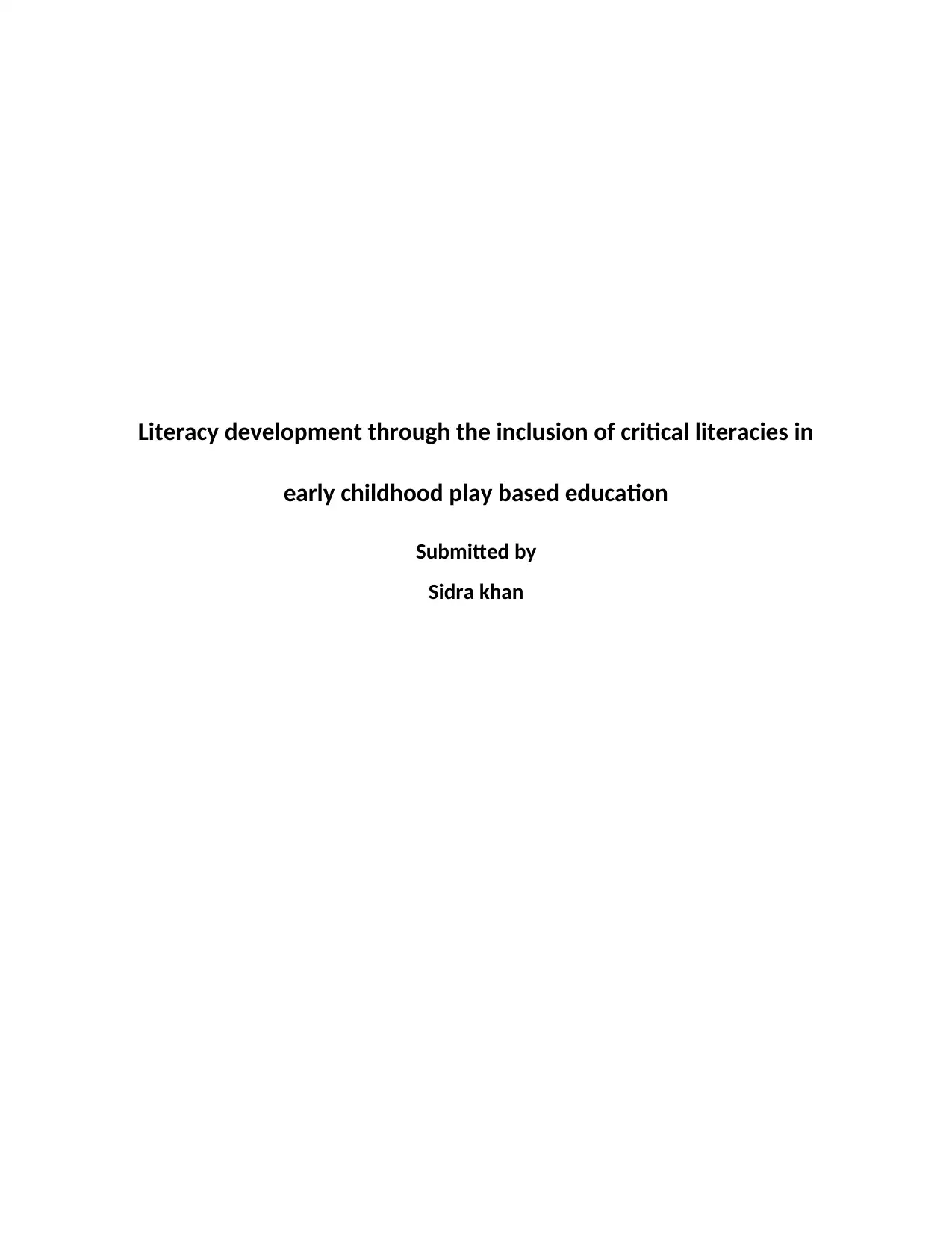
Literacy development through the inclusion of critical literacies in
early childhood play based education
Submitted by
Sidra khan
early childhood play based education
Submitted by
Sidra khan
Secure Best Marks with AI Grader
Need help grading? Try our AI Grader for instant feedback on your assignments.
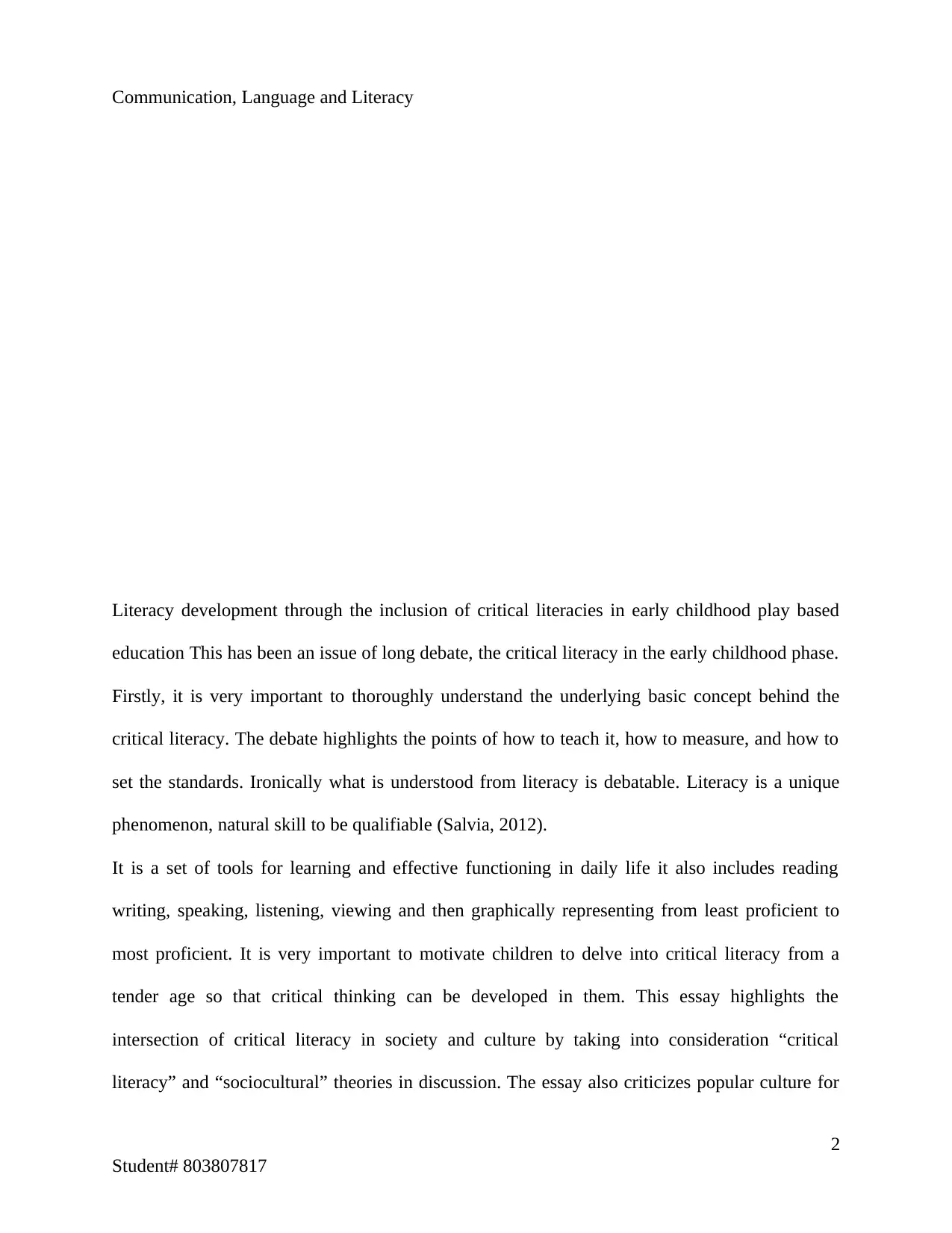
Communication, Language and Literacy
Literacy development through the inclusion of critical literacies in early childhood play based
education This has been an issue of long debate, the critical literacy in the early childhood phase.
Firstly, it is very important to thoroughly understand the underlying basic concept behind the
critical literacy. The debate highlights the points of how to teach it, how to measure, and how to
set the standards. Ironically what is understood from literacy is debatable. Literacy is a unique
phenomenon, natural skill to be qualifiable (Salvia, 2012).
It is a set of tools for learning and effective functioning in daily life it also includes reading
writing, speaking, listening, viewing and then graphically representing from least proficient to
most proficient. It is very important to motivate children to delve into critical literacy from a
tender age so that critical thinking can be developed in them. This essay highlights the
intersection of critical literacy in society and culture by taking into consideration “critical
literacy” and “sociocultural” theories in discussion. The essay also criticizes popular culture for
2
Student# 803807817
Literacy development through the inclusion of critical literacies in early childhood play based
education This has been an issue of long debate, the critical literacy in the early childhood phase.
Firstly, it is very important to thoroughly understand the underlying basic concept behind the
critical literacy. The debate highlights the points of how to teach it, how to measure, and how to
set the standards. Ironically what is understood from literacy is debatable. Literacy is a unique
phenomenon, natural skill to be qualifiable (Salvia, 2012).
It is a set of tools for learning and effective functioning in daily life it also includes reading
writing, speaking, listening, viewing and then graphically representing from least proficient to
most proficient. It is very important to motivate children to delve into critical literacy from a
tender age so that critical thinking can be developed in them. This essay highlights the
intersection of critical literacy in society and culture by taking into consideration “critical
literacy” and “sociocultural” theories in discussion. The essay also criticizes popular culture for
2
Student# 803807817

Communication, Language and Literacy
depicting consumerism. The essay also highlights the inclusion of critical literacy in childcare
settings and the manner in which it can be adopted to suit the needs of a diverse range of
learners.
The early aspect of learning establishes foundation upon which most contemporary human
beings develop their conception of the world. Effective literary development is one that
contributes and collaborates in the collective growth of the conscious for the greater good of both
the person and society. The idea of introducing diverse literary skills was itself new(Anthony,
2009). The critical literacy is typically dominated by the developmental theory with its
assumptions of the naturally developing child and emerging literacy. The critical literacy
concept of learning has its roots in the critical theory. It puts literacy and language as principle
aspect in creating continuation into asymmetrical power relations in the society. It is
understanding more simply as a concept based on learning through language and literacy
(Brighouse, Ladd, Loeb, & Swift, 2015).
Critical literacy highlights the important role of education in the extent to which the world-wide
views are expressed, heard, strengthened or ignored. The critical literacy uses text to refer to a
wide range of expressive medium. while seeing it is read uncritically the dominant view in the
world always appear to be correct, natural and strongly followed while the view less spoken
about less highlighted are either ignored or seem less true or powerful (Fellowes & Oakley,
2010). Critical literacy emphasizes on all texts being fundamentally biased. The perspective
behind a written text is based on the beliefs of the writer within the political, social and cultural
pools of knowledge. This denotes that critical literacy is a social practice. As Mitchell (2012)
states that all content is motivated, there is no neutral stance from where a test can be written or
read. An important aspect here is, to be totally independent to critically analyse text to be able to
3
Student# 803807817
depicting consumerism. The essay also highlights the inclusion of critical literacy in childcare
settings and the manner in which it can be adopted to suit the needs of a diverse range of
learners.
The early aspect of learning establishes foundation upon which most contemporary human
beings develop their conception of the world. Effective literary development is one that
contributes and collaborates in the collective growth of the conscious for the greater good of both
the person and society. The idea of introducing diverse literary skills was itself new(Anthony,
2009). The critical literacy is typically dominated by the developmental theory with its
assumptions of the naturally developing child and emerging literacy. The critical literacy
concept of learning has its roots in the critical theory. It puts literacy and language as principle
aspect in creating continuation into asymmetrical power relations in the society. It is
understanding more simply as a concept based on learning through language and literacy
(Brighouse, Ladd, Loeb, & Swift, 2015).
Critical literacy highlights the important role of education in the extent to which the world-wide
views are expressed, heard, strengthened or ignored. The critical literacy uses text to refer to a
wide range of expressive medium. while seeing it is read uncritically the dominant view in the
world always appear to be correct, natural and strongly followed while the view less spoken
about less highlighted are either ignored or seem less true or powerful (Fellowes & Oakley,
2010). Critical literacy emphasizes on all texts being fundamentally biased. The perspective
behind a written text is based on the beliefs of the writer within the political, social and cultural
pools of knowledge. This denotes that critical literacy is a social practice. As Mitchell (2012)
states that all content is motivated, there is no neutral stance from where a test can be written or
read. An important aspect here is, to be totally independent to critically analyse text to be able to
3
Student# 803807817
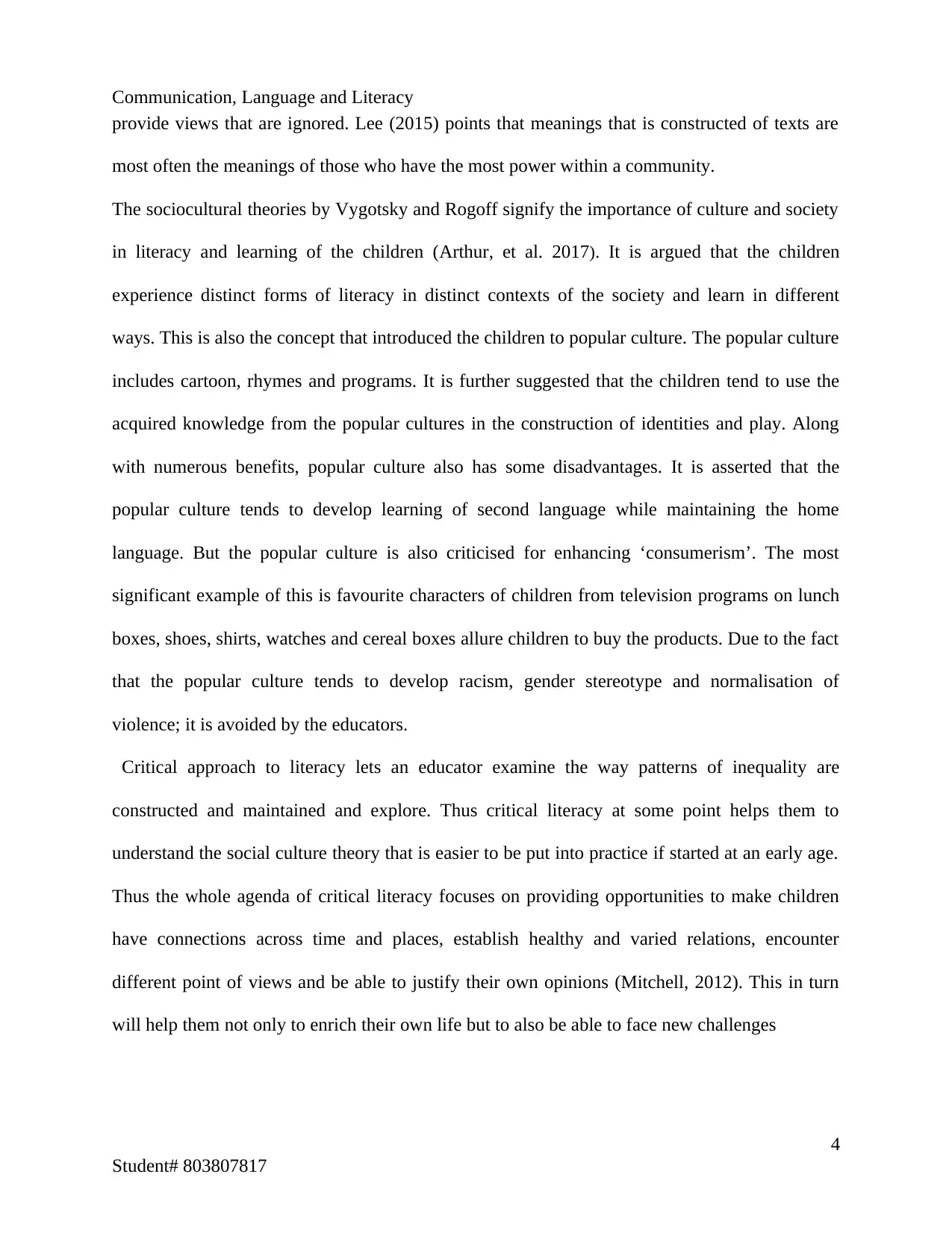
Communication, Language and Literacy
provide views that are ignored. Lee (2015) points that meanings that is constructed of texts are
most often the meanings of those who have the most power within a community.
The sociocultural theories by Vygotsky and Rogoff signify the importance of culture and society
in literacy and learning of the children (Arthur, et al. 2017). It is argued that the children
experience distinct forms of literacy in distinct contexts of the society and learn in different
ways. This is also the concept that introduced the children to popular culture. The popular culture
includes cartoon, rhymes and programs. It is further suggested that the children tend to use the
acquired knowledge from the popular cultures in the construction of identities and play. Along
with numerous benefits, popular culture also has some disadvantages. It is asserted that the
popular culture tends to develop learning of second language while maintaining the home
language. But the popular culture is also criticised for enhancing ‘consumerism’. The most
significant example of this is favourite characters of children from television programs on lunch
boxes, shoes, shirts, watches and cereal boxes allure children to buy the products. Due to the fact
that the popular culture tends to develop racism, gender stereotype and normalisation of
violence; it is avoided by the educators.
Critical approach to literacy lets an educator examine the way patterns of inequality are
constructed and maintained and explore. Thus critical literacy at some point helps them to
understand the social culture theory that is easier to be put into practice if started at an early age.
Thus the whole agenda of critical literacy focuses on providing opportunities to make children
have connections across time and places, establish healthy and varied relations, encounter
different point of views and be able to justify their own opinions (Mitchell, 2012). This in turn
will help them not only to enrich their own life but to also be able to face new challenges
4
Student# 803807817
provide views that are ignored. Lee (2015) points that meanings that is constructed of texts are
most often the meanings of those who have the most power within a community.
The sociocultural theories by Vygotsky and Rogoff signify the importance of culture and society
in literacy and learning of the children (Arthur, et al. 2017). It is argued that the children
experience distinct forms of literacy in distinct contexts of the society and learn in different
ways. This is also the concept that introduced the children to popular culture. The popular culture
includes cartoon, rhymes and programs. It is further suggested that the children tend to use the
acquired knowledge from the popular cultures in the construction of identities and play. Along
with numerous benefits, popular culture also has some disadvantages. It is asserted that the
popular culture tends to develop learning of second language while maintaining the home
language. But the popular culture is also criticised for enhancing ‘consumerism’. The most
significant example of this is favourite characters of children from television programs on lunch
boxes, shoes, shirts, watches and cereal boxes allure children to buy the products. Due to the fact
that the popular culture tends to develop racism, gender stereotype and normalisation of
violence; it is avoided by the educators.
Critical approach to literacy lets an educator examine the way patterns of inequality are
constructed and maintained and explore. Thus critical literacy at some point helps them to
understand the social culture theory that is easier to be put into practice if started at an early age.
Thus the whole agenda of critical literacy focuses on providing opportunities to make children
have connections across time and places, establish healthy and varied relations, encounter
different point of views and be able to justify their own opinions (Mitchell, 2012). This in turn
will help them not only to enrich their own life but to also be able to face new challenges
4
Student# 803807817
Secure Best Marks with AI Grader
Need help grading? Try our AI Grader for instant feedback on your assignments.
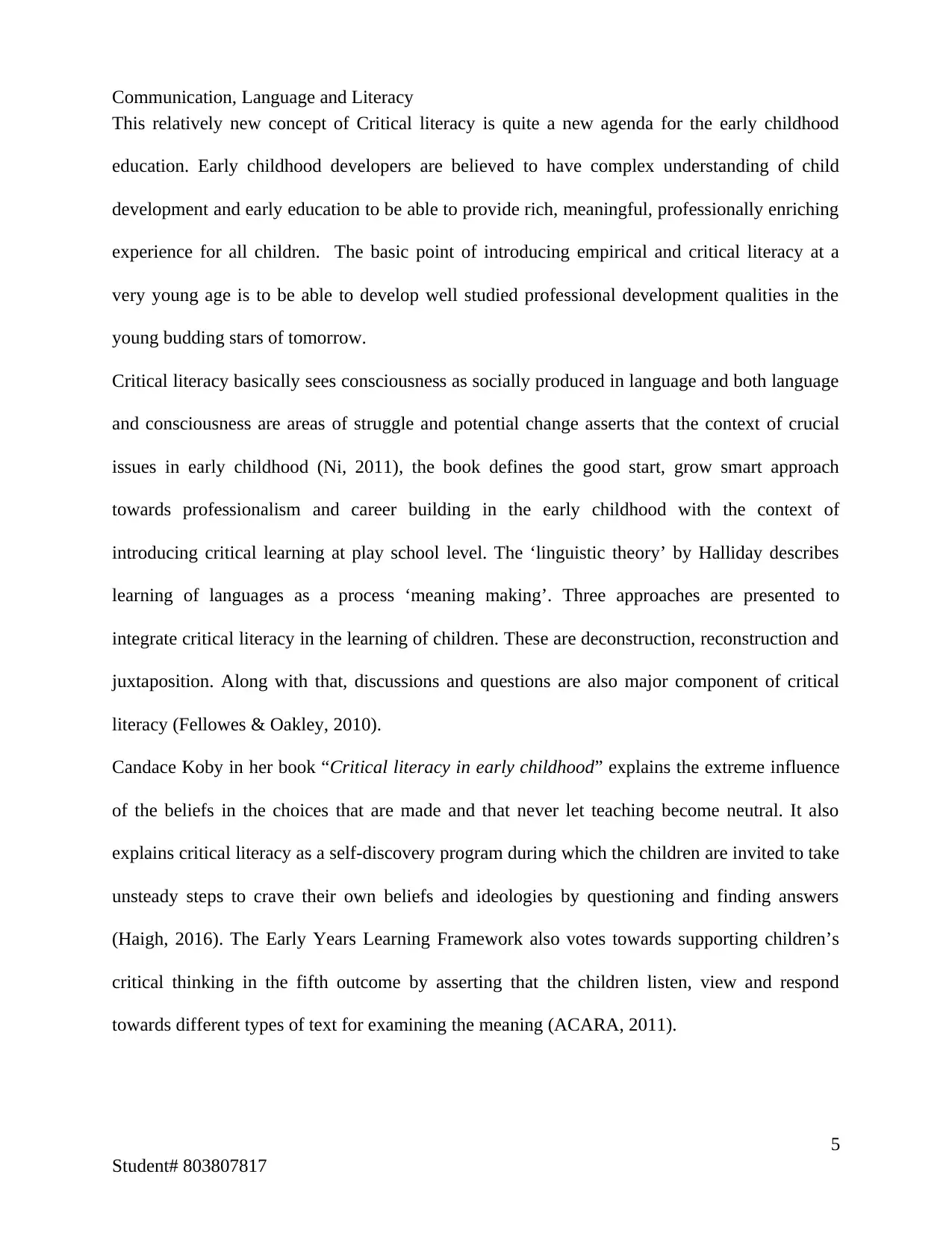
Communication, Language and Literacy
This relatively new concept of Critical literacy is quite a new agenda for the early childhood
education. Early childhood developers are believed to have complex understanding of child
development and early education to be able to provide rich, meaningful, professionally enriching
experience for all children. The basic point of introducing empirical and critical literacy at a
very young age is to be able to develop well studied professional development qualities in the
young budding stars of tomorrow.
Critical literacy basically sees consciousness as socially produced in language and both language
and consciousness are areas of struggle and potential change asserts that the context of crucial
issues in early childhood (Ni, 2011), the book defines the good start, grow smart approach
towards professionalism and career building in the early childhood with the context of
introducing critical learning at play school level. The ‘linguistic theory’ by Halliday describes
learning of languages as a process ‘meaning making’. Three approaches are presented to
integrate critical literacy in the learning of children. These are deconstruction, reconstruction and
juxtaposition. Along with that, discussions and questions are also major component of critical
literacy (Fellowes & Oakley, 2010).
Candace Koby in her book “Critical literacy in early childhood” explains the extreme influence
of the beliefs in the choices that are made and that never let teaching become neutral. It also
explains critical literacy as a self-discovery program during which the children are invited to take
unsteady steps to crave their own beliefs and ideologies by questioning and finding answers
(Haigh, 2016). The Early Years Learning Framework also votes towards supporting children’s
critical thinking in the fifth outcome by asserting that the children listen, view and respond
towards different types of text for examining the meaning (ACARA, 2011).
5
Student# 803807817
This relatively new concept of Critical literacy is quite a new agenda for the early childhood
education. Early childhood developers are believed to have complex understanding of child
development and early education to be able to provide rich, meaningful, professionally enriching
experience for all children. The basic point of introducing empirical and critical literacy at a
very young age is to be able to develop well studied professional development qualities in the
young budding stars of tomorrow.
Critical literacy basically sees consciousness as socially produced in language and both language
and consciousness are areas of struggle and potential change asserts that the context of crucial
issues in early childhood (Ni, 2011), the book defines the good start, grow smart approach
towards professionalism and career building in the early childhood with the context of
introducing critical learning at play school level. The ‘linguistic theory’ by Halliday describes
learning of languages as a process ‘meaning making’. Three approaches are presented to
integrate critical literacy in the learning of children. These are deconstruction, reconstruction and
juxtaposition. Along with that, discussions and questions are also major component of critical
literacy (Fellowes & Oakley, 2010).
Candace Koby in her book “Critical literacy in early childhood” explains the extreme influence
of the beliefs in the choices that are made and that never let teaching become neutral. It also
explains critical literacy as a self-discovery program during which the children are invited to take
unsteady steps to crave their own beliefs and ideologies by questioning and finding answers
(Haigh, 2016). The Early Years Learning Framework also votes towards supporting children’s
critical thinking in the fifth outcome by asserting that the children listen, view and respond
towards different types of text for examining the meaning (ACARA, 2011).
5
Student# 803807817

Communication, Language and Literacy
While emphasizing on the idea of critical literacy in child care setting the fact also cannot be
negated that there has to be balance between the conventional and critical learning.
Much attention and focus has always been given to reading at an early stage of life. Ni (2011)
states this has led to dumping down of the childcare setting curriculum. In order to just achieve
literacy standards but also to prepare children to be smartly ready to face the tomorrow's world
critical literacy practices are mandatory to be introduced as an integral part of the curriculum
from a very early age. There are number of ways that the element of critical literacy can be
inculcated in the play group curriculum children can be made involved in civil action. The
children can be encouraged to challenge the ideologies presented in the texts and more simply
giving them a practice to question their own lives and the lives of people they see around them.
A certain group although has total opposite views regarding the effectiveness of critical literacy
at a very early age. They believe that introducing this art at a very crisp age can snatch away the
natural innocence and growing process of the child. Discussing real issue with the child takes
away the charm of reading stories and creating imagination world (Bishop, 2014).
Even for diverse learner’s critical literacy may not equally prove all that effective, as children
from different linguistics background relate differently to different symbols and meanings. It is
necessary for the educators to collaborate with the families to incorporate a diverse range of text
to engage in equal opportunity in critical literacy. Messages construct in the texts do not always
tend to present the experience of their families and children and their vision towards the world
(Lee, 2015). This will happen in most cases with the children of the minority group. The children
may actively and openly start asking questions related to their contemporary and futuristic
gender related roles. Such practices may place a toddler in a feud with his guardians regarding
6
Student# 803807817
While emphasizing on the idea of critical literacy in child care setting the fact also cannot be
negated that there has to be balance between the conventional and critical learning.
Much attention and focus has always been given to reading at an early stage of life. Ni (2011)
states this has led to dumping down of the childcare setting curriculum. In order to just achieve
literacy standards but also to prepare children to be smartly ready to face the tomorrow's world
critical literacy practices are mandatory to be introduced as an integral part of the curriculum
from a very early age. There are number of ways that the element of critical literacy can be
inculcated in the play group curriculum children can be made involved in civil action. The
children can be encouraged to challenge the ideologies presented in the texts and more simply
giving them a practice to question their own lives and the lives of people they see around them.
A certain group although has total opposite views regarding the effectiveness of critical literacy
at a very early age. They believe that introducing this art at a very crisp age can snatch away the
natural innocence and growing process of the child. Discussing real issue with the child takes
away the charm of reading stories and creating imagination world (Bishop, 2014).
Even for diverse learner’s critical literacy may not equally prove all that effective, as children
from different linguistics background relate differently to different symbols and meanings. It is
necessary for the educators to collaborate with the families to incorporate a diverse range of text
to engage in equal opportunity in critical literacy. Messages construct in the texts do not always
tend to present the experience of their families and children and their vision towards the world
(Lee, 2015). This will happen in most cases with the children of the minority group. The children
may actively and openly start asking questions related to their contemporary and futuristic
gender related roles. Such practices may place a toddler in a feud with his guardians regarding
6
Student# 803807817
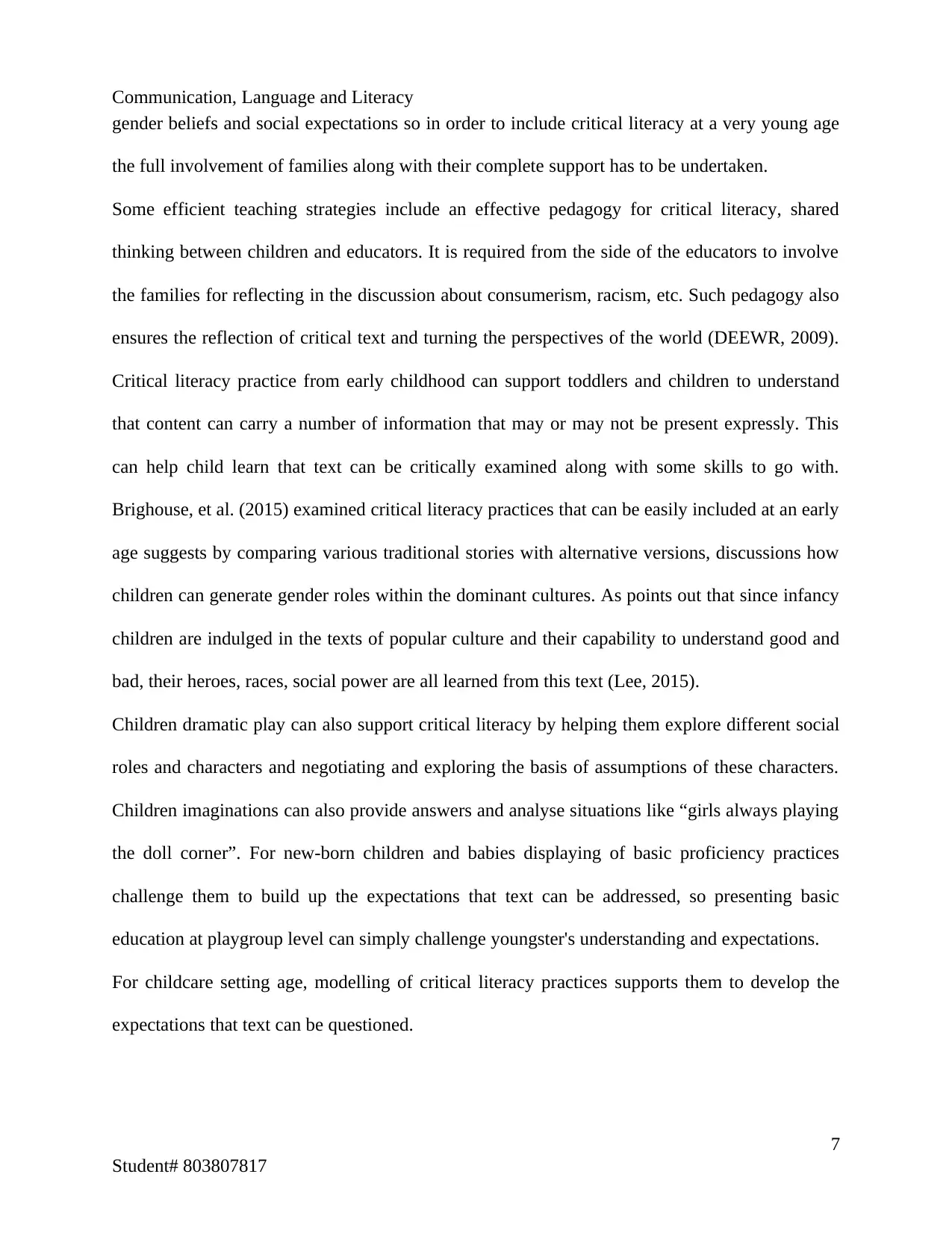
Communication, Language and Literacy
gender beliefs and social expectations so in order to include critical literacy at a very young age
the full involvement of families along with their complete support has to be undertaken.
Some efficient teaching strategies include an effective pedagogy for critical literacy, shared
thinking between children and educators. It is required from the side of the educators to involve
the families for reflecting in the discussion about consumerism, racism, etc. Such pedagogy also
ensures the reflection of critical text and turning the perspectives of the world (DEEWR, 2009).
Critical literacy practice from early childhood can support toddlers and children to understand
that content can carry a number of information that may or may not be present expressly. This
can help child learn that text can be critically examined along with some skills to go with.
Brighouse, et al. (2015) examined critical literacy practices that can be easily included at an early
age suggests by comparing various traditional stories with alternative versions, discussions how
children can generate gender roles within the dominant cultures. As points out that since infancy
children are indulged in the texts of popular culture and their capability to understand good and
bad, their heroes, races, social power are all learned from this text (Lee, 2015).
Children dramatic play can also support critical literacy by helping them explore different social
roles and characters and negotiating and exploring the basis of assumptions of these characters.
Children imaginations can also provide answers and analyse situations like “girls always playing
the doll corner”. For new-born children and babies displaying of basic proficiency practices
challenge them to build up the expectations that text can be addressed, so presenting basic
education at playgroup level can simply challenge youngster's understanding and expectations.
For childcare setting age, modelling of critical literacy practices supports them to develop the
expectations that text can be questioned.
7
Student# 803807817
gender beliefs and social expectations so in order to include critical literacy at a very young age
the full involvement of families along with their complete support has to be undertaken.
Some efficient teaching strategies include an effective pedagogy for critical literacy, shared
thinking between children and educators. It is required from the side of the educators to involve
the families for reflecting in the discussion about consumerism, racism, etc. Such pedagogy also
ensures the reflection of critical text and turning the perspectives of the world (DEEWR, 2009).
Critical literacy practice from early childhood can support toddlers and children to understand
that content can carry a number of information that may or may not be present expressly. This
can help child learn that text can be critically examined along with some skills to go with.
Brighouse, et al. (2015) examined critical literacy practices that can be easily included at an early
age suggests by comparing various traditional stories with alternative versions, discussions how
children can generate gender roles within the dominant cultures. As points out that since infancy
children are indulged in the texts of popular culture and their capability to understand good and
bad, their heroes, races, social power are all learned from this text (Lee, 2015).
Children dramatic play can also support critical literacy by helping them explore different social
roles and characters and negotiating and exploring the basis of assumptions of these characters.
Children imaginations can also provide answers and analyse situations like “girls always playing
the doll corner”. For new-born children and babies displaying of basic proficiency practices
challenge them to build up the expectations that text can be addressed, so presenting basic
education at playgroup level can simply challenge youngster's understanding and expectations.
For childcare setting age, modelling of critical literacy practices supports them to develop the
expectations that text can be questioned.
7
Student# 803807817
Paraphrase This Document
Need a fresh take? Get an instant paraphrase of this document with our AI Paraphraser

Communication, Language and Literacy
Introducing critical literacy at childcare setting level can always challenge child’s understanding
and expectations. It can be concluded by accepting the fact that the advent of critical learning
shapes our understanding of the world from various perspectives. Scholars come across so many
possible texts and messages that they can be trained to develop, understand, interact and respond
to any kind of situations in future.
Word Count: 1825
8
Student# 803807817
Introducing critical literacy at childcare setting level can always challenge child’s understanding
and expectations. It can be concluded by accepting the fact that the advent of critical learning
shapes our understanding of the world from various perspectives. Scholars come across so many
possible texts and messages that they can be trained to develop, understand, interact and respond
to any kind of situations in future.
Word Count: 1825
8
Student# 803807817
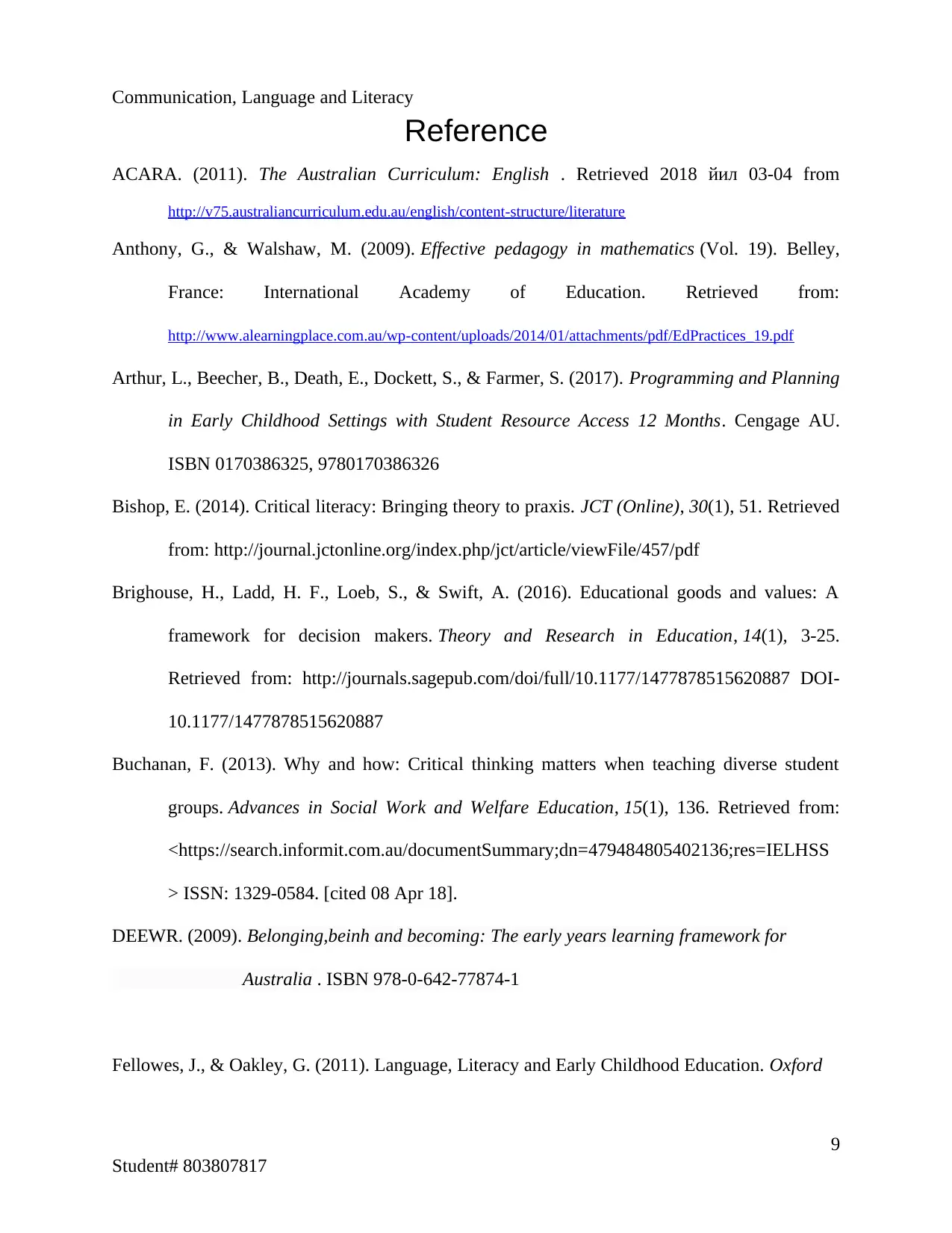
Communication, Language and Literacy
Reference
ACARA. (2011). The Australian Curriculum: English . Retrieved 2018 йил 03-04 from
http://v75.australiancurriculum.edu.au/english/content-structure/literature
Anthony, G., & Walshaw, M. (2009). Effective pedagogy in mathematics (Vol. 19). Belley,
France: International Academy of Education. Retrieved from:
http://www.alearningplace.com.au/wp-content/uploads/2014/01/attachments/pdf/EdPractices_19.pdf
Arthur, L., Beecher, B., Death, E., Dockett, S., & Farmer, S. (2017). Programming and Planning
in Early Childhood Settings with Student Resource Access 12 Months. Cengage AU.
ISBN 0170386325, 9780170386326
Bishop, E. (2014). Critical literacy: Bringing theory to praxis. JCT (Online), 30(1), 51. Retrieved
from: http://journal.jctonline.org/index.php/jct/article/viewFile/457/pdf
Brighouse, H., Ladd, H. F., Loeb, S., & Swift, A. (2016). Educational goods and values: A
framework for decision makers. Theory and Research in Education, 14(1), 3-25.
Retrieved from: http://journals.sagepub.com/doi/full/10.1177/1477878515620887 DOI-
10.1177/1477878515620887
Buchanan, F. (2013). Why and how: Critical thinking matters when teaching diverse student
groups. Advances in Social Work and Welfare Education, 15(1), 136. Retrieved from:
<https://search.informit.com.au/documentSummary;dn=479484805402136;res=IELHSS
> ISSN: 1329-0584. [cited 08 Apr 18].
DEEWR. (2009). Belonging,beinh and becoming: The early years learning framework for
Australia . ISBN 978-0-642-77874-1
Fellowes, J., & Oakley, G. (2011). Language, Literacy and Early Childhood Education. Oxford
9
Student# 803807817
Reference
ACARA. (2011). The Australian Curriculum: English . Retrieved 2018 йил 03-04 from
http://v75.australiancurriculum.edu.au/english/content-structure/literature
Anthony, G., & Walshaw, M. (2009). Effective pedagogy in mathematics (Vol. 19). Belley,
France: International Academy of Education. Retrieved from:
http://www.alearningplace.com.au/wp-content/uploads/2014/01/attachments/pdf/EdPractices_19.pdf
Arthur, L., Beecher, B., Death, E., Dockett, S., & Farmer, S. (2017). Programming and Planning
in Early Childhood Settings with Student Resource Access 12 Months. Cengage AU.
ISBN 0170386325, 9780170386326
Bishop, E. (2014). Critical literacy: Bringing theory to praxis. JCT (Online), 30(1), 51. Retrieved
from: http://journal.jctonline.org/index.php/jct/article/viewFile/457/pdf
Brighouse, H., Ladd, H. F., Loeb, S., & Swift, A. (2016). Educational goods and values: A
framework for decision makers. Theory and Research in Education, 14(1), 3-25.
Retrieved from: http://journals.sagepub.com/doi/full/10.1177/1477878515620887 DOI-
10.1177/1477878515620887
Buchanan, F. (2013). Why and how: Critical thinking matters when teaching diverse student
groups. Advances in Social Work and Welfare Education, 15(1), 136. Retrieved from:
<https://search.informit.com.au/documentSummary;dn=479484805402136;res=IELHSS
> ISSN: 1329-0584. [cited 08 Apr 18].
DEEWR. (2009). Belonging,beinh and becoming: The early years learning framework for
Australia . ISBN 978-0-642-77874-1
Fellowes, J., & Oakley, G. (2011). Language, Literacy and Early Childhood Education. Oxford
9
Student# 803807817
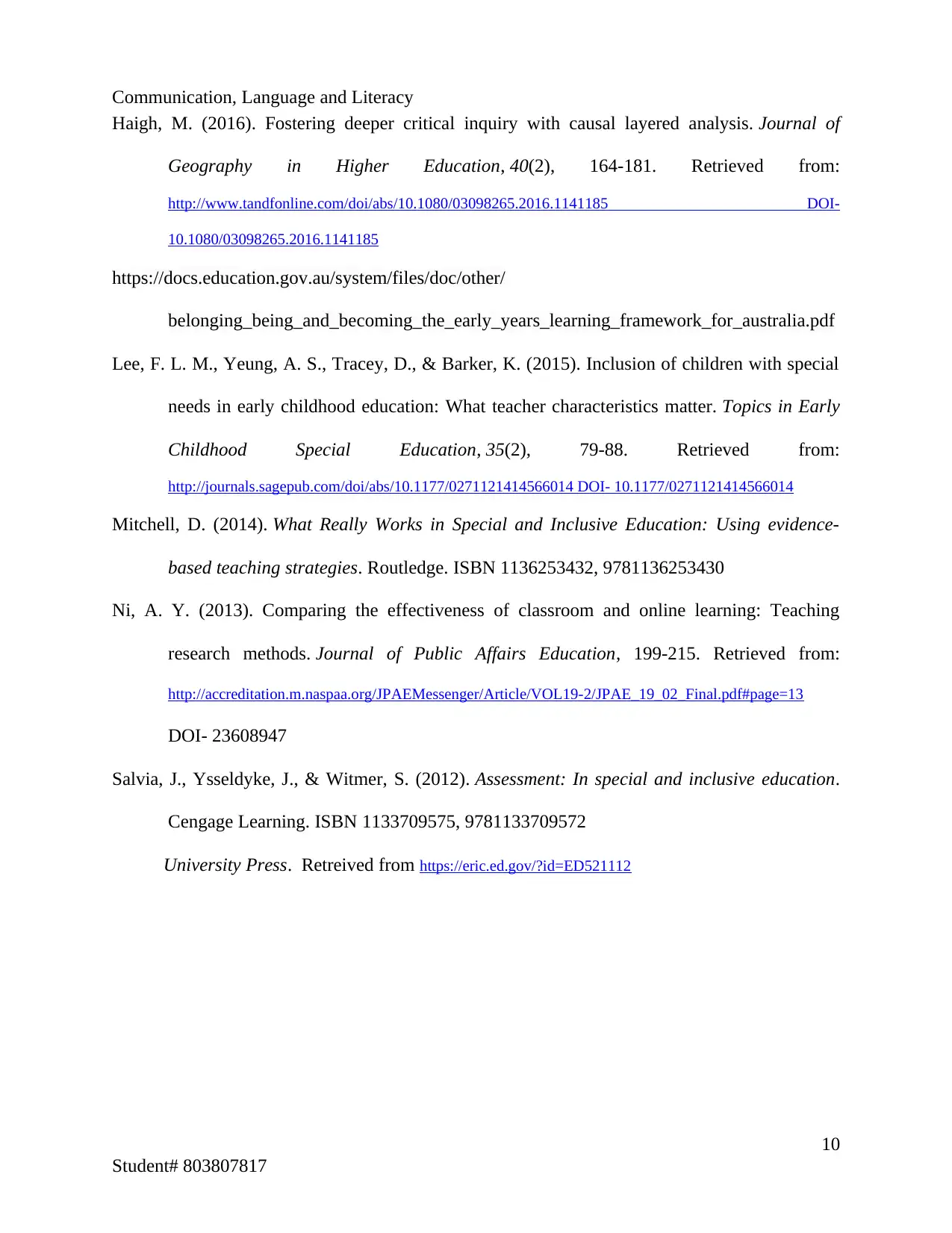
Communication, Language and Literacy
Haigh, M. (2016). Fostering deeper critical inquiry with causal layered analysis. Journal of
Geography in Higher Education, 40(2), 164-181. Retrieved from:
http://www.tandfonline.com/doi/abs/10.1080/03098265.2016.1141185 DOI-
10.1080/03098265.2016.1141185
https://docs.education.gov.au/system/files/doc/other/
belonging_being_and_becoming_the_early_years_learning_framework_for_australia.pdf
Lee, F. L. M., Yeung, A. S., Tracey, D., & Barker, K. (2015). Inclusion of children with special
needs in early childhood education: What teacher characteristics matter. Topics in Early
Childhood Special Education, 35(2), 79-88. Retrieved from:
http://journals.sagepub.com/doi/abs/10.1177/0271121414566014 DOI- 10.1177/0271121414566014
Mitchell, D. (2014). What Really Works in Special and Inclusive Education: Using evidence-
based teaching strategies. Routledge. ISBN 1136253432, 9781136253430
Ni, A. Y. (2013). Comparing the effectiveness of classroom and online learning: Teaching
research methods. Journal of Public Affairs Education, 199-215. Retrieved from:
http://accreditation.m.naspaa.org/JPAEMessenger/Article/VOL19-2/JPAE_19_02_Final.pdf#page=13
DOI- 23608947
Salvia, J., Ysseldyke, J., & Witmer, S. (2012). Assessment: In special and inclusive education.
Cengage Learning. ISBN 1133709575, 9781133709572
University Press. Retreived from https://eric.ed.gov/?id=ED521112
10
Student# 803807817
Haigh, M. (2016). Fostering deeper critical inquiry with causal layered analysis. Journal of
Geography in Higher Education, 40(2), 164-181. Retrieved from:
http://www.tandfonline.com/doi/abs/10.1080/03098265.2016.1141185 DOI-
10.1080/03098265.2016.1141185
https://docs.education.gov.au/system/files/doc/other/
belonging_being_and_becoming_the_early_years_learning_framework_for_australia.pdf
Lee, F. L. M., Yeung, A. S., Tracey, D., & Barker, K. (2015). Inclusion of children with special
needs in early childhood education: What teacher characteristics matter. Topics in Early
Childhood Special Education, 35(2), 79-88. Retrieved from:
http://journals.sagepub.com/doi/abs/10.1177/0271121414566014 DOI- 10.1177/0271121414566014
Mitchell, D. (2014). What Really Works in Special and Inclusive Education: Using evidence-
based teaching strategies. Routledge. ISBN 1136253432, 9781136253430
Ni, A. Y. (2013). Comparing the effectiveness of classroom and online learning: Teaching
research methods. Journal of Public Affairs Education, 199-215. Retrieved from:
http://accreditation.m.naspaa.org/JPAEMessenger/Article/VOL19-2/JPAE_19_02_Final.pdf#page=13
DOI- 23608947
Salvia, J., Ysseldyke, J., & Witmer, S. (2012). Assessment: In special and inclusive education.
Cengage Learning. ISBN 1133709575, 9781133709572
University Press. Retreived from https://eric.ed.gov/?id=ED521112
10
Student# 803807817
1 out of 10
Related Documents
Your All-in-One AI-Powered Toolkit for Academic Success.
+13062052269
info@desklib.com
Available 24*7 on WhatsApp / Email
![[object Object]](/_next/static/media/star-bottom.7253800d.svg)
Unlock your academic potential
© 2024 | Zucol Services PVT LTD | All rights reserved.




